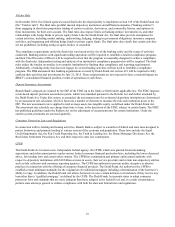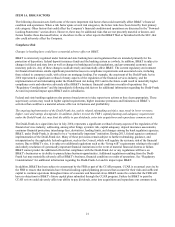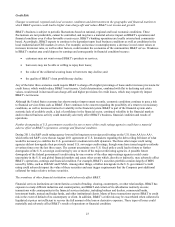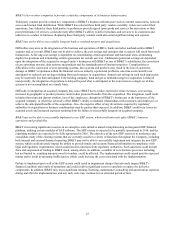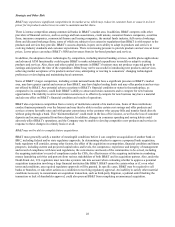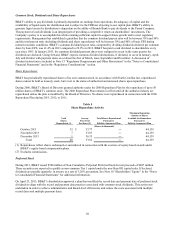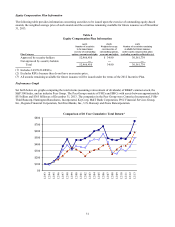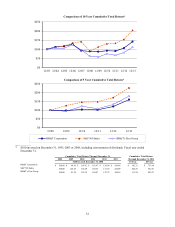BB&T 2013 Annual Report Download - page 23
Download and view the complete annual report
Please find page 23 of the 2013 BB&T annual report below. You can navigate through the pages in the report by either clicking on the pages listed below, or by using the keyword search tool below to find specific information within the annual report.23
Credit Risk
Changes in national, regional and local economic conditions and deterioration in the geographic and financial markets in
which BB&T operates could lead to higher loan charge-offs and reduce BB&T’s net income and growth.
BB&T’s business is subject to periodic fluctuations based on national, regional and local economic conditions. These
fluctuations are not predictable, cannot be controlled, and may have a material adverse impact on BB&T’s operations and
financial condition even if other favorable events occur. BB&T’s banking operations are locally oriented and community-
based. Accordingly, BB&T expects to continue to be dependent upon local business conditions as well as conditions in the
local residential and CRE markets it serves. For example, an increase in unemployment, a decrease in real estate values or
increases in interest rates, as well as other factors, could weaken the economies of the communities BB&T serves. Weakness
in BB&T’s market area could depress its earnings and consequently its financial condition because:
customers may not want or need BB&T’s products or services;
borrowers may not be able or willing to repay their loans;
the value of the collateral securing loans to borrowers may decline; and
the quality of BB&T’s loan portfolio may decline.
Any of the latter three scenarios could require BB&T to charge off a higher percentage of loans and/or increase provisions for
credit losses, which would reduce BB&T’s net income. Credit deterioration, combined with flat to declining real estate
values, would result in increased loan charge-offs and higher provisions for credit losses, which may negatively impact
BB&T’s net income.
Although the United States economy has shown modest improvement recently, economic conditions continue to pose a risk
to financial services firms such as BB&T. There continues to be concern regarding the possibility of a return to recessionary
conditions, as well as increased turmoil or volatility in the financial system. BB&T is part of the financial system and a
systemic lack of available credit, a lack of confidence in the financial sector, continued volatility in the financial markets
and/or reduced business activity could materially adversely affect BB&T’s business, financial condition and results of
operations.
Further downgrades of U.S. government securities by one or more of the credit ratings agencies could have a material
adverse effect on BB&T’s operations, earnings and financial condition.
During 2011, the S&P credit rating agency lowered its long term sovereign credit rating on the U.S. from AAA to AA+,
which reflected S&P’s view that an August 2011 agreement of U.S. lawmakers regarding the debt ceiling fell short of what
would be necessary to stabilize the U.S. government’s medium term debt dynamics. The three other major credit rating
agencies did not downgrade their previously issued U.S. sovereign credit ratings, though some have issued negative outlooks
at various times over the last three years. The current uncertainty over U.S. fiscal policy could lead to future or further
downgrades of the U.S. sovereign credit rating by one or more of the major credit rating agencies. A possible future
downgrade of the federal government’s credit rating by one or more of the other major ratings agencies could create
uncertainty in the U.S. and global financial markets and cause other events which, directly or indirectly, may adversely affect
BB&T’s operations, earnings and financial condition. For example, BB&T’s securities portfolio consists largely of MBS
issued by GSEs, such as FHLMC and FNMA. Among other things, a further downgrade in the U.S. government’s credit
rating could adversely impact the value of these securities and may trigger requirements that the Company post additional
collateral for trades relative to these securities.
The soundness of other financial institutions could adversely affect BB&T.
Financial services institutions are interrelated as a result of trading, clearing, counterparty, or other relationships. BB&T has
exposure to many different industries and counterparties, and BB&T and certain of its subsidiaries routinely execute
transactions with counterparties in the financial services industry, including brokers and dealers, commercial banks,
investment banks, mutual and hedge funds, and other institutional clients. Many of these transactions expose BB&T to credit
risk in the event of default of its counterparty or client. In addition, BB&T’s credit risk may be exacerbated when collateral is
liquidated at prices not sufficient to recover the full amount of the loan or derivative exposure. These types of losses could
materially and adversely affect BB&T’s results of operations or financial condition.





